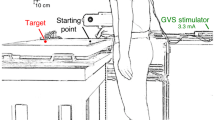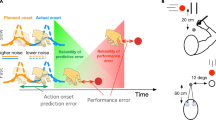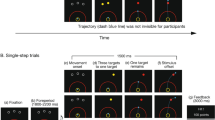Summary
The amendment of large-magnitude errors is discussed with particular reference to the correction of directional errors. It is argued that the correction of a large-magnitude error may be understood as a double-step tracking situation in which the second step reflects an artificially induced error signal. At issue is how the motor system may respond to such stimuli in rapid succession. The temporal integration of error stimuli predicts an initial response which reflects the weighted average of the step positions. This approach, however, does not explain the marked increase in peak velocity for the corrective response, compared to an equivalent single-step response. Alternatively, it has been argued that the initial response is initiated as if it were a single-step response to the initial step position and is subsequently amended. The superposition hypothesis argued that the two responses are planned in parallel and overlap in time, to be superimposed one on the other. This hypothesis does not explain changes in the direction of a double-step response at its initiation. The braking hypothesis argues that the initial response is halted and a corrective response initiated as rapidly as possible. This approach cannot explain changes in the slope of an ATF as a function of the second target-step amplitude. A model of double-step tracking is proposed which integrates the temporal integration and braking hypotheses. Since the braking of the initial response would involve the application of large forces, it is argued that braking is facilitated by the temporal integration of step stimuli. The corrective response is then implemented as rapidly as possible. The implications of these findings to the understanding of directional errors is discussed.
Similar content being viewed by others
References
Angel, R. W. (1976). Efference copy in the control of movement. Neurology, 26, 1164–1168.
Angel, R. W., Garland, H., & Fischler, M. (1971). Tracking errors amended without visual feedback. Journal of Experimental Psychology, 89, 422–424.
Angel, R. W., & Higgins, J. R. (1969). Correction of false moves in pursuit tracking. Journal of Experimental Psychology, 82, 185–187.
Barrett, N. C., & Glencross, D. J. (1988a). The double step analysis of rapid manual aiming movements. Quarterly Journal of Experimental Psychology, 40A, 299–322.
Barrett, N. C., & Glencross, D. J. (1988b). The amplitude transition function and the manual and oculomotor control systems. Psychological Bulletin, 104, 363–372.
Becker, W.,. & Jurgens, R. (1975). Saccadic reactions to double-step stimuli: Evidence for model feedback and continuous information uptake. In G. Lennerstrand & P. Bach-y-Rica (Eds.), Basic mechanisms of ocular motility and their clinical implications (pp. 111–119). Oxford: Pergamon Press.
Becker, W., & Jürgens, R. (1979). An analysis of the saccadic system by means of double step stimuli. Vision Research, 19, 967–983.
Becker, W., King, W. M., Fuchs, A. F., Jurgens, R., Johanson, G., & Kornhuber, H. H. (1981). Accuracy of goal directed saccades and mechanisms of error correction. In A. F. Fuchs & W. Becker (Eds.), Progress in Oculomotor Research (pp. 29–37). Elsevier, North-Holland: Amsterdam.
Beggs, W. D. A., & Howarth, C. I. (1970). Movement control in a repetitive motor task. Nature, 225, 752–753.
Bertelson, P. (1966). Central intermittency twenty years later. Quarterly Journal of Experimental Psychology, 18, 153–163.
Carlow, T., Dell' Osso, L. F., Troost, B. T., Daroff, R. B., & Birkett, J. E. (1975). Saccadic eye movement latencies to multi-model stimuli. Intersubject variability and temporal efficiency. Vision Research, 15, 1257–1263.
Carlton, L. G. (1981a). Processing visual feedback information for movement control. Journal of Experimental Psychology: Human perception and Performance, 7, 1019–1030.
Carlton, L. G. (1981b). Visual information: The control of aiming movements. Quarterly Journal of Experimental Psychology, 33A, 87–93.
Carpenter, R. H. S. (1977). Movements of the eyes. London: Pion.
Chernikoff, R., & Taylor, F. V. (1952). Reaction time to kinaesthetic stimulation resulting from sudden arm displacement. Journal of Experimental Psychology, 43, 1–8.
Cooke, J. D., & Diggles, V. A. (1984). Rapid error correction during human arm movements: Evidence for central monitoring. Journal of Motor Behaviour, 16, 348–363.
Deubel, H., Wolf, W., & Hauske, G. (1984). The evaluation of the oculomotor error signal. In A. G. Gale & F. Johnson (Eds.), Theoretical and applied aspects of eye movement research (pp. 55–62). Amsterdam: Elsevier/North-Holland.
Elliot, D., & Allard, F. (1985). The utilization of visual feedback information during rapid pointing movements. Quarterly Journal of Experimental Psychology, 37A, 407–425.
Fel'dman, A. G. (1980a). Superposition of motor programs — 1. Rhythmic forearm movements in man. Neuroscience, 5, 81–90.
Fel'dman, A. G. (1980b). Superposition of motor programs — 2. Rapid forearm flexion in man. Neuroscience, 5, 91–95.
Fel'dman, A. G. (1986). Once more on the equilibrium-point hypothesis (-model) for motor control. Journal of Motor Behaviour, 18, 17–54.
Flash, T., & Henis, E. (1991). Arm trajectory modification during reaching towards visual targets. Journal of Cognitive Neuroscience, 3, 220–230.
Flash, T., Hems, E., Inzelberg, R., & Korczyn, A. D. (1992). Timing and sequencing of human arm trajectories: Normal and abnormal motor behaviour. Human Movement Science, 11, 83–100.
Georgopoulos, A. P. (1986). On reaching. Annual Review of Neuroscience, 9, 147–170.
Georgopoulos, A. P., Kalaska, J. F., & Massey, J. T. (1981). Spatial trajectories and reaction times of aimed movements: Effects of practice, uncertainty and change in target location. Journal of Neurophysiology, 46, 725–743.
Gibbs, C. B. (1965). Probability learning in step-input tracking. British Journal of Psychology, 56, 233–242.
Gielen, C. C. A. M., Van den Heuvel, P. J. M., & Dernier van der gon, J. J. (1984). Modification of muscle activation patterns during fast goal directed arm movements. Journal of Motor Behaviour, 16, 2–19.
Gottsdanker, R. (1966). The effect of superseding signals. Quarterly Journal of Experimental Psychology, 18, 236–249.
Gottsdanker, R. (1973). Psychological refractoriness and the organization of step tracking responses. Perception & Psychophysics, 14, 60–70.
Guthrie, B. L., Porter, J. D., & Sparks, D. L. (1983). Corollary discharge provides accurate eye position information to the oculomotor system. Science, 221, 1193–1195.
Higgins, J. R., & Angel, R. W. (1970). Correction of tracking errors without sensory feedback. Journal of Experimental Psychology, 84, 412–416.
Jaeger, R. J., Agarwal, G. C., & Gottlieb, G. L. (1979). Directional errors of movement and their correction in a discrete tracking task. Journal of Motor Behavior, 11, 123–133.
Keele, S. W., & Posner, M. I. (1968). Processing of visual feedback in rapid movement. Journal of Experimental Psychology, 77, 155–158.
Kelso, J. A. S., & Stelmach, G. E. (1976). Central and peripheral mechanisms in motor control. In G. E. Stelmach (Ed.), Motor control: Issues and trends (pp. 1–46). Orlando, FL: Academic Press.
Massey, J. T., Schwartz, A. B., & Georgopoulos, A. P. (1986). On information processing and performing a movement sequence. Experimental Brain Research Suppl., 15, 242–251.
Megaw, E. D. (1972). Direction and extent uncertainty in step-input tracking. Journal of Motor Behaviour, 4, 171–186.
Morris, R. (1981). Error correction paradigms: A possible confounding. In G. C. Roberts & D. M. Landers (Eds.), Psychology of motor behaviour. Champaign, IL: Human Kinetics.
Robinson, D. A. (1973). Models of the saccadic eye movement control system. Kybernetik, 14, 71–83.
Schmidt, R. A. (1975). A schema theory of discrete motor skill learning. Psychological Review, 82, 225–260.
Schmidt, R. A., & Gordon, G. B. (1977). Errors in motor responding, “rapid” corrections, and false anticipations. Journal of Motor Behaviour, 9, 101–111.
Smith, W. M., & Bowen, K. F. (1980). The effects of delayed and displaced visual feedback on motor control. Journal of Motor Behavior, 8, 43–58.
Van Sonderen, J. F., Denier van der Gon, J. J., & Gielen, C. C. A. M. (1988). Conditions determining early modification of motor programs in response to change in target location. Experimental Brain Research, 71, 320–328.
Woodworth, R. S. (1899). The accuracy of voluntary movement. Psychological Review, 3 (2, Whole No. 13).
Zelaznik, H. N., Hawkins, B., & Kisselburgh, L. (1983). Rapid visual feedback processing in single-aiming movements. Journal of Motor Behavior, 15, 217–236.
Author information
Authors and Affiliations
Rights and permissions
About this article
Cite this article
Barrett, N.C. The amendment of large-magnitude aiming-movement errors. Psychol. Res 55, 148–155 (1993). https://doi.org/10.1007/BF00419647
Issue Date:
DOI: https://doi.org/10.1007/BF00419647




